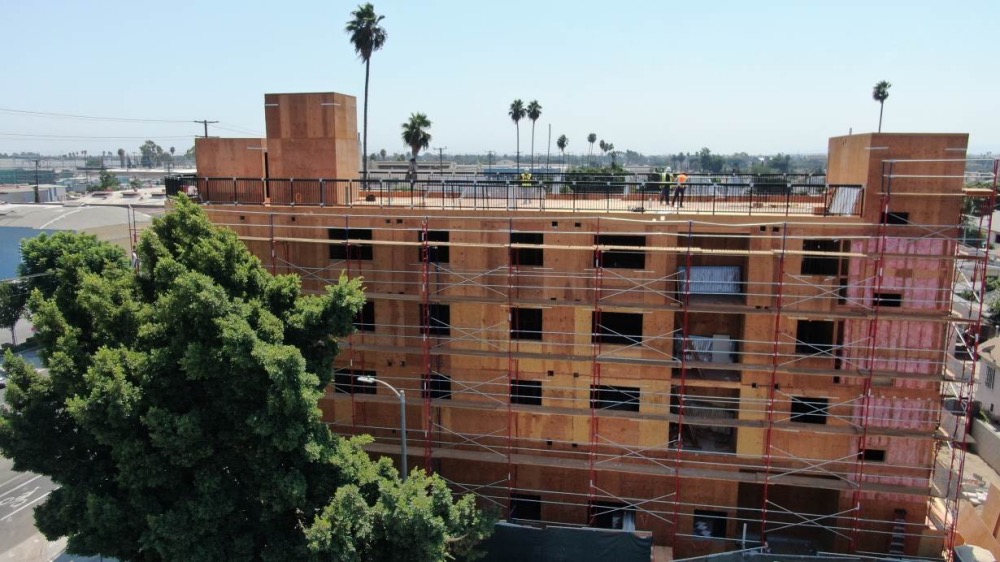
CAREY L BIRON, writing for the Thomson Reuters Foundation, on hopes deprived neighbourhoods in the US could benefit from a new push to spur investment…
Washington DC, US
Thomson Reuters Foundation
Changes to a US tax provision aiming to transform poor neighbourhoods could get a boost as a Democratic Senate makes it easier for President-elect Joe Biden to push through his legislative agenda.
Democrats last week completed a sweep of the two US Senate seats in the state of Georgia, giving the party control of the chamber – and the prospect of enacting Biden-backed changes to a law that could spur investment in deprived areas.

An affordable housing development is under construction in an area of Los Angeles deemed an opportunity zone. PICTURE: Martin Cuellar/SoLa Impact.
Martin Muoto’s firm has been helping build affordable housing in South Los Angeles for nearly a decade, but it was only recently that he was able to start enticing many others to invest in the impoverished area.
The developer credits the turnaround to a tax provision known as “opportunity zones” which, when it became law in 2017, was met with widespread hope that it could help steer investors toward neighbourhoods that rarely receive such attention.
The law seeks to entice investors to low-income areas by offering tax incentives if they stick with a project – say, a housing development – for a decade rather than looking for a quick return, and if they can show that they are adding value.
The program has “allowed us to invest significantly in Black and brown communities because these have historically been overlooked and underinvested,” Muoto, the founder of real estate investment company SoLa Impact, said in a phone interview.
Opportunity zones have “increased by five or 10 times the number of investors willing to talk with us,” added Muoto, whose firm is using the incentives to put together $1 billion for a Black Impact Fund aimed at boosting minority areas.
The law seeks to entice investors to low-income areas by offering tax incentives if they stick with a project – say, a housing development – for a decade rather than looking for a quick return, and if they can show that they are adding value.
But, Muoto notes, not everyone follows the spirit of the law to focus on investments with community benefit.
Now, he and others who share this concern are looking to the incoming administration under Biden to overhaul the program.
Biden’s campaign platform includes a pledge to “reform opportunity zones to fulfil their promise”, noting that “in too many instances investors favor high-return projects like luxury apartments over affordable housing and local entrepreneurs”.
The pledge suggests that, done well, opportunity zones offer a way to help “close the racial wealth gap”.
When it was announced, the opportunity zones legislation was seen as potentially transformative for affordable housing and urban development, said Brett Theodos, a senior fellow at the Urban Institute, a DC-based thinktank.
But, as President Donald Trump’s administration rolled out rules on how opportunity zones would be implemented, Theodos said, it became increasingly clear that the program would fall short of its potential.
“We are seeing the program largely go to projects or communities that don’t need the help,” said Theodos, who co-authored a review of opportunity zones that the Biden campaign included in its plan.
The US Treasury Department, which oversees the program, said in emailed comments that opportunity zones “have successfully brought investment into communities that investors had previously overlooked”.
By the end of 2019, $US75 billion in private capital had been invested in opportunity zones, “most of which would not have entered [these areas] without the incentive,” it said.
Those investments will lift a million people from poverty, according to the White House website.
Across the country, nearly 8,800 areas with more than 30 million residents have been designated as opportunity zones, covering about half of the country’s “pockets of concentrated persistent poverty,” according to Senator Tim Scott, who co-authored the law.
Yet, while many applauded the law’s original vision, today there is widespread frustration with the program.
Two key concerns are around the types of investments that are eligible under opportunity zone guidelines – almost anything, said Theodos – and data on projects themselves.
“One of the law’s biggest flaws is very apparent – there’s no data ,” said Jesse Van Tol, chief executive of the National Community Reinvestment Coalition, a Washington-based non-profit.
“We have no idea of the impact of a tax giveaway other than anecdotal. We don’t even know what the projects have been,” he told the Thomson Reuters Foundation.
Van Tol said the program also needs guidelines to align investments with community priorities, for instance by purposefully involving local governments and organizations.
Still, his group is actively lobbying the incoming Biden administration on the issue, in the belief that the law’s potential remains significant.
“Opportunity zones with some important changes could have a positive impact,” he said.

Those who support changes to the law say the Biden administration also needs to ensure areas that do benefit from these investments do not end up becoming gentrified.
“What we’ve seen traditionally is when there is investment into previously divested communities, typically communities of colour are often pushed out,” said Bridgett A Simmons, staff attorney with the non-profit National Housing Law Project.
Among other issues, her organisation is calling on the Biden administration to look at how opportunity zones will affect federal housing.
“If the public housing is in great disrepair, we need to think about how to not just demolish it but [how] to preserve it, and if it’s even possible to attract some funding to renovate the property,” she said.
The aim needs to be “effectively keeping subsidized families in those communities so they can benefit from the new investment.”
That is a key priority for Baltimore, which has 42 opportunity zones, said Ben Seigel, opportunity zone coordinator for the Baltimore Development Corp, a city office.
“We’ve been successful in attracting lots of investors to look at Baltimore who hadn’t previously been active in Baltimore, or hadn’t been in certain neighbourhoods.”
– Ben Seigel, opportunity zone coordinator for the Baltimore Development Corp.
“We’ve been successful in attracting lots of investors to look at Baltimore who hadn’t previously been active in Baltimore, or hadn’t been in certain neighbourhoods,” he said.
A project to convert abandoned row houses into workforce housing, for example, would not have happened without the new incentives, he said.
Still, Seigel said he has seen only “mixed results” on opportunity zones so far.
He and his colleagues are hoping for various changes under the Biden administration, including mandating public reporting on investments and ensuring that projects have documented community impact.
Those changes would “add teeth” to what Baltimore is trying to accomplish, Seigel said.
“The next two years will really reveal the impact that opportunity zones can have, and I do think the policy tweaks that the incoming administration can make will be an important step in meeting that potential,” he said.





